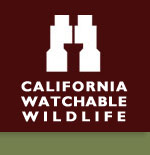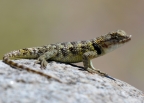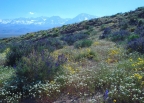

| Area: More than Acres | ||
| Lat: | ||
| Lon: | ||
| Nearby Services | ||
| Site Facilities | ||
| Join Our Mailing List |
|
For Email Marketing you can trust
|
Top Banner Photo Credits
Pam Starr
Alyn Robert Brereton
Julie MacKinnon
Linda Pittman
Parham Pourahmad
Larry Whiting
Randall Finley
Pam Starr
Alyn Robert Brereton
Julie MacKinnon
Linda Pittman
Parham Pourahmad
Larry Whiting
Randall Finley
© 2008-2024 California Watchable Wildlife and Blue Cat Studio, Inc.
| Fish Slough Ecological Reserve & Fish Slough Area of Critical Environmental Concern (ACEC) - Site # 78 | |||
| Three natural springs flow from volcanic cliffs and form a desert wetland that provides 80% of the world’s remaining habitat for endangered Owens pupfish. These rare native fish are found in less than ¼-acre of clear ponds at three locations. Yellow-headed blackbirds, prairie falcons, green-winged teal, and black-crowned night herons are also seen here. | |||
 | Seasonal - these sites have high wildlife values during certain seasons, though they may have recreational value year-round. | ||



.jpg)



| |||
| Background: | Surrounded by volcanic cliffs, three natural springs feed a stream which flows through a cooperatively managed (California Department of Fish & Wildlife, Bureau of Land Management and Los Angeles Department of Water and Power) marsh, including two locations that serve as sanctuaries for native fish of the Owens Valley. The two- to three-inch, endangered Owens pupfish is easy to recognize by its distinctive 'start-stop' swimming style, vertical stripes, and the blue hue sported by territorial males throughout most of the year. Often-seen marsh breeding birds include Northern Harrier, Common Yellowthroat and Marsh Wren. Alkali meadows and the arid Volcanic Tableland offer dramatically different plant and wildlife communities. | ||
| The Fish Slough Area of Critical Environmental Concern (ACEC) encompasses several outstanding petroglyph sites, where native people chipped cryptic symbols into rock surfaces in ancient times. One site is less than a mile north of the native fish sanctuary, on the left (west) side of Fish Slough Road. The Volcanic Tableland surrounding the slough is a fascinating geological feature, formed by consolidation of hot ash ejected from the Long Valley Caldera, and eroded into unusual forms. | |||
| The Habitat: | Wetland, permanently or seasonally saturated (2%); alkali flat and alkali scrub (2%); upland desert scrub, Volcanic Tableland (96%) | ||
| The Experience: | Fish Slough is a desert wetland providing an oasis of rich wildlife habitat as well as a location where species can form and persist in isolation. Its rare alkali meadow plant community supports the threatened Fish Slough milk-vetch, found nowhere else, along with eight other rare plant species. Its waters were the last stronghold for the endangered Owens pupfish, once thought to be extinct; refuges are maintained here for this and other native fish species (the rare Owens speckled dace and Owens sucker) and the endemic Fish Slough springsnail. The Reserve and ACEC encompass more than 36,000 acres. | ||
| Wildlife and Where to Find It: | Park and easy walk to wetland. | ||
| Viewing Tips: | High probability of seeing wildlife. Birds of prey are seen year-round; Owens pupfish are easiest to see during the April- August breeding season at BLM Spring. Waterfowl and wading birds are most common in fall and winter. Songbirds are present year-round and most diverse during spring and fall; rare migrants may be seen. Black-tailed jackrabbits, white-tailed antelope squirrels, and several lizard species are common year-round. | ||
| Site Notes: | Clear water bubbles up in the springs, two of which are maintained as refuges for native fish, and flows south into streams and shallow ponds where you'll find non-native fish such as bass. The long, narrow strip of wetland vegetation, green in summer and golden in winter, is surrounded by seasonally wet alkali meadows and alkali flats. Here the soil is often encrusted with a white dusting of evaporated minerals, and is home to rare alkali-adapted plants. Out beyond these lies the Volcanic Tableland, a vast dry desert whose pink-hued rock may be interspersed with a colorful display of spring wildflowers in a wet year. The Tableland is by no means table-top flat: a high, steep bluff rises all along the east side of the slough; the gradual slope to the west is warped and cracked by faulting; and huge, weirdly-shaped boulders show the erosive force of the wind. | ||
| Nearby Viewing Sites: | From intersection of Fish Slough Road and Five Bridges Road, take Chalk Bluff Road west; watch for raptors; end at Pleasant Valley Reservoir for waterfowl viewing. Mount Whitney Fish Hatchery, Mono Basin National Forest Scenic Area Visitor Center | ||
| Festivals & Events: | Owens Lake Bird Festival Mono Basin Bird Chautauqua | ||
| Visitor Information: | Bishop Area Chamber of Commerce and Visitors Bureau - (760) 873-8405 - www.bishopvisitor.com | ||
| Viewing Site Hours of Operation are: | |||
| Staff On-site: | No | ||
| Open: | Everday | ||
| Hours: | 24 hours | ||
| Year Round: | Yes | ||
| Seasonal: | It can be very warm here during summer months but visitation is year-round. | ||
| Road Information: | |||
| Road Hazards: See below under parking. | |||
| Parking Fee: No | |||
| Proximity to viewing area:Less than 1/4 mile. | |||
| Parking Notes: Very soft shoulders - use established pull-offs only. Fish Slough Road is graded dirt, well-maintained but with very soft shoulder; use established turnouts. Side roads may be explored but are non-maintained; some are rocky and/or sandy and require high clearance and/or 4WD. No off-road driving allowed. | |||
| How to Get There: | In Bishop, take Highway 395 north to Highway 6. Drive north on Highway 6 for 1.5 miles, turn northwest (left) on Five Bridges Road. Drive about 2.5 miles. Shortly after the sand and gravel plant, turn north (right) on Fish Slough Road. Go 6.5 miles to fenced pond. Marshlands will be on east side of road as you drive to pond. | ||
| Contact Information | |||
| Managing Agency: | California Department of Fish & Wildlife | ||
| Agency Site URL: | https://www.wildlife.ca.gov/Lands/Places-to-Visit/Fish-Slough-ER | ||
| Physical Address: | 787 N. Main Street Suite 220 Bishop, CA 93514 Bishop, CA 93514 |
Agency 2: | , CA |
| Manager Phone: | (760) 872-1171 | Contact Us: | by Email |
| Site Phone: | CDFW - (760) 872-1171 | ||
| County: | Inyo, Mono | ||
| Addition Website: | https://www.recreation.gov/recreationalAreaDetails.do?contractCo | ||
